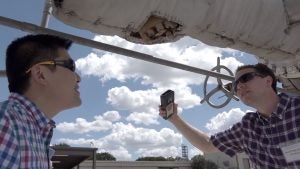 This post was co-authored by Drew Pomerantz, a research scientist at Schlumberger.
This post was co-authored by Drew Pomerantz, a research scientist at Schlumberger.
Isabel Mogstad, a Project Manager with EDF+Business, who previously worked as a management consultant for Schlumberger, and Drew Pomerantz, a research scientist with Schlumberger, took this opportunity to have a conversation about why an oilfield service company wants to get involved with methane detection.
Isabel: Why do environmental issues matter to Schlumberger?
Drew: In one of my first training classes when I was a new employee, I was taught that Schlumberger and our customers have an obligation to produce energy with as little environmental impact as possible. Today, that obligation can be a competitive advantage in the market, which increasingly wants to understand where its energy is coming from and increasingly demands cleaner energy. As the world makes this transition to lower-carbon sources of energy, the oil and gas industry must adapt. Schlumberger in particular must position itself to be an environmental leader as much as it is a technology leader to continue its success. Because methane is responsible for a quarter of the warming we experience today, and the most efficient and lowest-cost opportunities to reduce methane emissions are available in the oil and gas sector, managing methane makes sense for Schlumberger.
Isabel: How and why does Schlumberger want to bring methane mitigation to their customers?
Drew: I think the distinction between an oil and gas company and an oilfield service company is important to answering this question. Service companies like Schlumberger develop expertise in performing specific tasks like drilling a well, and in some cases oil companies find it more efficient to contract those tasks to service companies than to perform the tasks themselves. If service companies like Schlumberger can develop increasingly effective methane mitigation technology, then oil and gas companies that prefer to contract their methane management to service companies would have a more straightforward path to reducing methane emissions. In that way, I hope Schlumberger’s efforts can help reduce the methane emissions from a large fraction of the industry while potentially opening a new line of business for Schlumberger itself.
Isabel: Last summer, our organizations worked together to test methane detection technologies. What led Schlumberger to that point? What did you learn?
Drew: Schlumberger’s effort in methane detection started around two years ago, with the initial goal of trying to understand what new technologies were being developed for emissions detection. Starting then, we spoke with around 100 companies and university groups developing technology for this application. To really understand the technology, we felt we had to hold the instruments in our own hands and use them to find gas leaks ourselves. So, working with EDF, we arranged an outdoor field test of the 15 technologies we thought were most promising. The results of that test are detailed in a report from Southwest Research Institute. Perhaps unsurprisingly, we learned that one of the main technical challenges in pinpointing leak location is the wind. Nearly all emissions detectors measure methane concentration, not methane leak rate, and the wind can complicate the way those detectors are used–a high wind can lower the concentration near a leak and even raise the concentration far from a leak. New instrument technologies that improve the accuracy and precision of the measurements are helpful, but in practice technologies that reduce the complicating effects of the wind can be even more important.
Isabel: Schlumberger has joined EDF, Stanford’s Natural Gas Initiative, and others in a new challenge to identify and test the most promising tools for mobile detection and quantification of methane leaks. What is Schlumberger hoping to get out of the project?
Drew: From an industry perspective, one of the most promising approaches to identify emissions is to use sensors mounted on airplanes, helicopters and drones. While those technologies were beyond the scope of the EDF/Schlumberger project, they are the focus of the Mobile Monitoring Challenge. We have two goals for the project. Initially, we hope to learn about this new class of technology and how it can be integrated with the sensors we looked at earlier. More broadly, we hope this project accelerates the deployment of airborne methane detectors in the upstream industry. Studies by EDF scientists and others are showing that a significant fraction of upstream methane emissions arise from a small number of super-emitters, and airborne detectors may be the most effective way to detect those. Before airborne detectors find widespread use, that promise will have to be proven to oil and gas companies, regulators, and the public, and we hope this project can advance that process.









